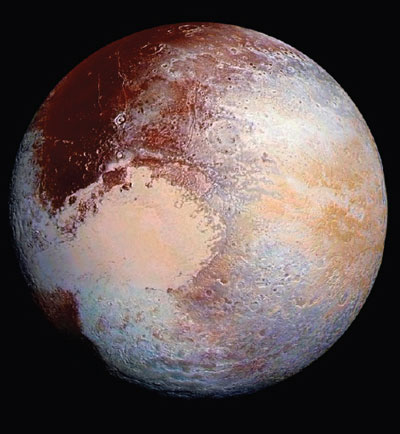
Assisting with the observations was Leslie Young, who had recently earned a physics degree and was not yet in grad school. In 1988, astronomers using an airborne NASA telescope watched Pluto pass in front of a star for five minutes, and saw the light dim not suddenly, as it would have if the planet were airless, but gradually, revealing it had a wisp of an atmosphere. Years later, scientists would learn that Pluto’s ices are dominated by even more exotic frosts of nitrogen and carbon monoxide, which exist only because temperatures on Pluto are around –380 degrees Fahrenheit. It seemed like a heroic feat in 1976 when a trio of astronomers probing Pluto’s infrared spectrum detected methane, which they deduced was frozen on its surface. Not until 1978 did astronomers detect its Texas-size moon Charon, about half the size of Pluto itself (even now no one is sure exactly how big Pluto is, but the estimated diameter is 1,430 miles, roughly two-thirds the size of Earth’s moon). There was reason to think Pluto might be just as strange and exciting.ĭiscovered in 1930 after a nearly year-long telescopic search by a young observatory assistant named Clyde Tombaugh, Pluto is so faint and so distant-its 248-year orbit averages 3.7 billion miles from the sun-that almost half a century elapsed before astronomers had the technology to study it. Voyager’s images revealed weird, contorted terrains and, to everyone’s amazement, geysers of frozen nitrogen. The idea became even more appealing after Voyager 2’s Neptune flyby, when scientists got their first good look at the icy moon Triton, thought to be a close cousin of Pluto. Stern rallied several young scientists, and even a few older ones, to take up the cause. Mission control for New Horizons is at the Johns Hopkins Applied Physics Lab in Maryland. “I was a young guy,” he recalls, “and senior guys in the field, guys that were in their 50s then, would say to me, ‘Are you kidding me? Everyone will be dead by the time we get there.’ Meaning they would be dead.
Nasa news about pluto how to#
in astrophysics and planetary science, Stern was already thinking about how to get NASA to send a mission to the ninth planet. To him, the exploration of the solar system was unfinished. Most scientists were untroubled that Pluto had been left out. And so, after passing Saturn in 1980, Voyager 1 headed off toward interstellar space, and the Grand Tour ended with Voyager 2’s flyby of Neptune in August 1989. At one time planners had considered including Pluto on Voyager 1’s itinerary, but instead chose a flight path that would allow close flybys of more alluring targets like Saturn’s moon Titan. Twenty-five years ago, when he began his Pluto quest, planetary scientists were still anticipating the conclusion of the Grand Tour of the outer solar system by the twin Voyager spacecraft, launched in 1977. Almost everything about getting to Pluto has been a struggle. By now, as the mission’s principal investigator and the driving force behind its creation, Stern is used to tension.

Stern, who is based at the Southwest Research Institute in Boulder, Colorado, says, “That should be a nail-biter.” He says it almost cheerfully, as if he welcomes the ordeal. Thirteen hours earlier, the 1,100-pound, grand-piano-size probe called New Horizons will have sped past the dwarf planet and its retinue of moons, gathering close-up images and other data that Stern expects will “rewrite the textbooks.” That is, if New Horizons manages to avoid colliding with particles of dust and ice, which-at a flyby speed of 31,000 mph-could destroy the craft before it has a chance to transmit its findings to Earth. If the signal arrives as planned, he will know that the reconnaissance of Pluto he spent the last 25 years working toward has succeeded. The signal will make its way to a command center in Maryland, where planetary scientist Alan Stern will be waiting. Eastern time, a burst of radio telemetry will complete a three-billion-mile trek to arrive at one of the huge dish antennas of NASA’s Deep Space Network.


 0 kommentar(er)
0 kommentar(er)
